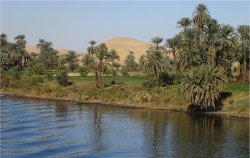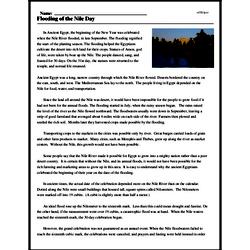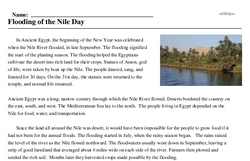Flooding of the Nile Day
Flooding of the Nile Day
Reading Comprehension for August 16
In Ancient Egypt, the beginning of the New Year was celebrated when the Nile River flooded, in late September. The flooding signified the start of the planting season. The flooding helped the Egyptians cultivate the desert into rich land for their crops. Statues of Amon, god of life, were taken by boat up the Nile. The people danced, sang, and feasted for 30 days. On the 31st day, the statues were returned to the temple, and normal life resumed.
Ancient Egypt was a long, narrow country through which the Nile River flowed. Deserts bordered the country on the east, south, and west. The Mediterranean Sea lay to the north. The people living in Egypt depended on the Nile for food, water, and transportation.
Since the land all around the Nile was desert, it would have been impossible for the people to grow food if it had not been for the annual floods. The flooding started in July, when the rainy season began. The rains raised the level of the river as the Nile flowed northward. The floodwaters usually went down in September, leaving a strip of good farmland that averaged about 6 miles wide on each side of the river. Farmers then plowed and seeded the rich soil. Months later they harvested crops made possible by the flooding.




